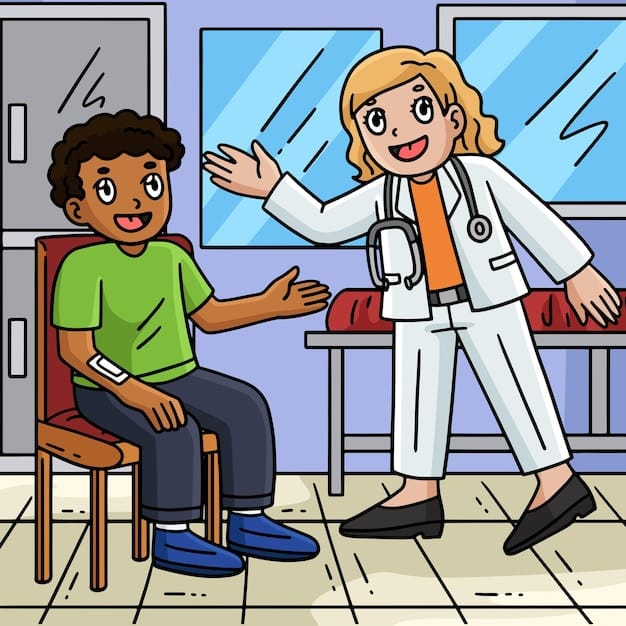Understanding SCHIP: Healthcare for Your Children in the US

The State Children’s Health Insurance Program (SCHIP), now often referred to as the Children’s Health Insurance Program (CHIP), is a crucial initiative in the United States that provides low-cost health coverage to children in families who earn too much to qualify for Medicaid but cannot afford private insurance.
Navigating healthcare options for your children can be overwhelming. The **State Children’s Health Insurance Program (SCHIP)**, also known as CHIP, offers a vital lifeline to families in the US, ensuring access to affordable healthcare for children who might otherwise go without.
What is the State Children’s Health Insurance Program (SCHIP)?
The State Children’s Health Insurance Program (SCHIP), now commonly called the Children’s Health Insurance Program (CHIP), is a joint federal and state government initiative designed to provide low-cost health coverage. It targets uninsured children in families whose incomes are modest but too high to qualify for Medicaid.
CHIP operates under federal guidelines but each state has flexibility in designing its own program, offering a variety of coverage options to best meet the needs of its residents.

Key Features of CHIP
CHIP provides comprehensive health coverage, including doctor visits, immunizations, dental care, and hospital services. Here are some key aspects:
- Eligibility is primarily based on family income and varies by state.
- Coverage is typically more affordable than private insurance.
- CHIP covers a wide range of healthcare services ensuring children’s well-being.
- The program aims to reduce the number of uninsured children and promote preventive care.
How CHIP Works
Funding for CHIP comes from both the federal government and individual states. States administer their CHIP programs, determining specific benefits, eligibility criteria, and cost-sharing arrangements.
Typically, families pay monthly premiums and/or co-payments for services, although these costs are generally lower than those associated with private insurance plans.
In summary, CHIP is a crucial healthcare safety net for children from low-to-moderate income families, promoting their access to necessary medical services and contributing to their overall health and development.
Who is Eligible for CHIP?
Determining eligibility for the Children’s Health Insurance Program (CHIP) involves several factors, primarily focusing on a child’s age, residency, and family income. Generally, CHIP is designed for children who are not eligible for Medicaid but whose families cannot afford private health insurance.
Understanding these eligibility requirements is essential for families seeking affordable healthcare coverage for their children. Here’s a breakdown of the key criteria:
Age and Residency Requirements
Most CHIP programs cover children up to the age of 19. Additionally, children must be residents of the state in which they are applying for coverage. These basic requirements ensure that the program serves the intended population within each state.
Some states also require the child to be a U.S. citizen or a qualified alien; however, emergency medical care may be available regardless of immigration status.
- Children must be under 19 years old.
- Applicants need to reside in the state where they apply.
- Some states require U.S. citizenship or qualified alien status.
Income Limits and Family Size
Income eligibility varies significantly by state, as each CHIP program sets its own income thresholds based on the federal poverty level (FPL). Generally, CHIP targets families with incomes too high for Medicaid but too low to afford private insurance.
These income limits are also adjusted based on family size, meaning that larger families can qualify even with higher incomes. To find the specific income limits in your state, you should consult your state’s CHIP website or contact their program directly.
In conclusion, eligibility for CHIP depends on a combination of age, residency, and income criteria, ensuring that the program reaches children in families who need it most. Contacting your state’s CHIP office remains the best way of determining eligibility.
What Does CHIP Cover?
The Children’s Health Insurance Program (CHIP) offers comprehensive healthcare coverage to enrolled children, ensuring they have access to essential medical services. While specific benefits may vary by state, CHIP generally covers a wide array of healthcare needs.
Understanding exactly what CHIP covers can help you make informed decisions about your child’s healthcare. Here’s an overview of the typical services included:
CHIP typically covers standard check-ups, which is crucial to assess a child’s overall health and development.

Core Healthcare Services
Most CHIP programs provide coverage for routine check-ups, immunizations, doctor visits, and hospital care. These core services are fundamental to maintaining children’s health and preventing serious illnesses.
Additionally, CHIP often includes coverage for emergency care, mental health services, and substance abuse treatment, addressing both physical and mental well-being.
- Well-child visits and regular check-ups.
- Vaccinations to prevent childhood diseases.
- Hospital care and emergency services.
- Mental health and substance abuse treatment.
Additional Benefits
In addition to the core healthcare services, many CHIP programs offer dental and vision care. These benefits are crucial for children’s oral and visual health, which can significantly impact their overall quality of life.
Some states also provide additional services such as prescription drug coverage, physical therapy, and specialized treatments for chronic conditions.
In summary, CHIP offers a robust package of healthcare benefits, ensuring that children have access to the medical, dental, and vision care they need to thrive.
How to Apply for CHIP
Applying for the Children’s Health Insurance Program (CHIP) is a straightforward process, although the specific steps can vary slightly depending on the state you live in. Generally, the application process involves gathering necessary documentation, completing an application form, and submitting it to the appropriate state agency.
Here’s a step-by-step guide to help you navigate the CHIP application process:
Research Your State’s CHIP Program
The first step in applying for CHIP is to research your state’s specific program. Each state has its own CHIP program, with unique names, eligibility criteria, and application processes. Visit your state’s Medicaid or Health Department website to find detailed information.
You can also call your state’s CHIP office directly to ask questions and get clarification on any requirements. Knowing the specifics of your state’s program will make the application process smoother.
- Visit your state’s Medicaid or Health Department website.
- Call your state’s CHIP office.
- Understand income and residency criteria.
Gather Required Documentation
Before you start the application, gather all the required documentation. This typically includes proof of income, residency, and citizenship or immigration status for each family member.
You may also need to provide social security numbers, birth certificates, and information about any existing health insurance coverage. Having all these documents on hand will expedite the application process.
In conclusion, applying for CHIP involves researching your state’s program, gathering required documentation, completing the application accurately, and following up with the state agency. This will increase your chances of successfully securing affordable healthcare coverage.
CHIP vs. Medicaid: Understanding the Differences
Both the Children’s Health Insurance Program (CHIP) and Medicaid provide health coverage to children from low-income families, but they differ in several key aspects. Understanding these differences is crucial for determining which program is most appropriate for your family’s needs.
While Medicaid is primarily for very low-income individuals and families, CHIP is designed for families who do not qualify for Medicaid but cannot afford private health insurance. This distinction in income eligibility is a primary factor in deciding which program to apply for.
Eligibility Criteria
Medicaid generally has stricter income requirements than CHIP, making it accessible to the neediest families. CHIP, on the other hand, targets families with slightly higher incomes who still struggle to afford private insurance.
Eligibility for Medicaid also often depends on factors such as age, disability, and family status, while CHIP primarily focuses on children’s coverage up to age 19.
- Medicaid has stricter income requirements.
- CHIP serves families above Medicaid income limits.
- Medicaid eligibility depends on various factors.
Benefits and Coverage
Both CHIP and Medicaid offer comprehensive healthcare benefits, including doctor visits, hospital care, and preventive services. However, the specific benefits and cost-sharing arrangements can vary between the two programs.
Medicaid often provides more extensive benefits, such as long-term care services, while CHIP may have limitations on certain services or require co-payments. However, CHIP generally has lower premiums than private insurance options.
In summary, while both CHIP and Medicaid aim to provide healthcare coverage to children, they differ significantly in their eligibility criteria, benefits, and scope. Understanding these distinctions can help families make informed decisions to find the most suitable coverage.
The Future of CHIP: Challenges and Opportunities
The Children’s Health Insurance Program (CHIP) has been a vital source of healthcare coverage for millions of children in the United States. However, the program faces ongoing challenges and opportunities as healthcare landscapes evolve.
One of the primary challenges is ensuring the continuous, long-term funding for CHIP. Given its dependence on federal and state funding, the program’s stability can be affected by budgetary constraints and political priorities.
Funding and Sustainability
Maintaining consistent funding levels is critical to ensure that CHIP can continue to provide healthcare coverage to eligible children. Periodic funding renewals by Congress often create uncertainty about the program’s future.
States also face financial challenges in contributing their share of CHIP funding, which can affect the program’s ability to expand or maintain coverage.
- Ensuring continuous federal and state funding.
- Addressing budgetary constraints and political priorities.
- Promoting stable, long-term program financing.
Expanding Access and Improving Quality
CHIP has the opportunity to further expand access to healthcare for uninsured children and improve the quality of care provided. This can involve outreach efforts to enroll eligible families and partnerships with healthcare providers to enhance services.
Additionally, CHIP can focus on addressing healthcare disparities and promoting preventive care to improve children’s overall health outcomes.
In conclusion, while CHIP faces challenges related to funding and sustainability, it also has opportunities to expand access, improve quality, and address healthcare disparities. Addressing these issues is crucial to ensure that CHIP continues to serve as a vital healthcare safety net for children.
| Key Point | Brief Description |
|---|---|
| ✅ CHIP Overview | Provides low-cost health coverage to children in families with modest incomes. |
| 💰 Eligibility | Based on age, residency, and family income, varying by state, for children under 19. |
| 🏥 Coverage | Includes check-ups, immunizations, hospital care, and, in some states, dental and vision care. |
| 📝 Application | Involves researching state programs, gathering documents, and completing the CHIP application. |
[Frequently Asked Questions (FAQ)]
▼
The main goal of the Children’s Health Insurance Program (CHIP) is to provide low-cost health coverage to uninsured children in families who earn too much to qualify for Medicaid but cannot afford private insurance.
▼
To find the specific income limits for CHIP in your state, visit your state’s Medicaid or Health Department website. You can also contact your state’s CHIP office directly for detailed information.
▼
CHIP typically covers a wide range of healthcare services, including routine check-ups, immunizations, doctor visits, hospital care, emergency services, mental health treatment, and sometimes dental and vision care, depending on the state.
▼
CHIP differs from Medicaid primarily in its eligibility criteria. Medicaid is generally intended for very low-income individuals and families, while CHIP targets families who do not qualify for Medicaid but cannot afford private health insurance.
▼
Some common challenges facing CHIP include ensuring stable and continuous funding, addressing budgetary constraints, expanding access to healthcare for uninsured children, and improving the quality of care provided.
Conclusion
The State Children’s Health Insurance Program (SCHIP) plays a crucial role in ensuring that children in the United States have access to affordable and comprehensive healthcare. By understanding the program’s eligibility requirements, coverage benefits, and application process, families can take advantage of this valuable resource to safeguard their children’s health and well-being.





